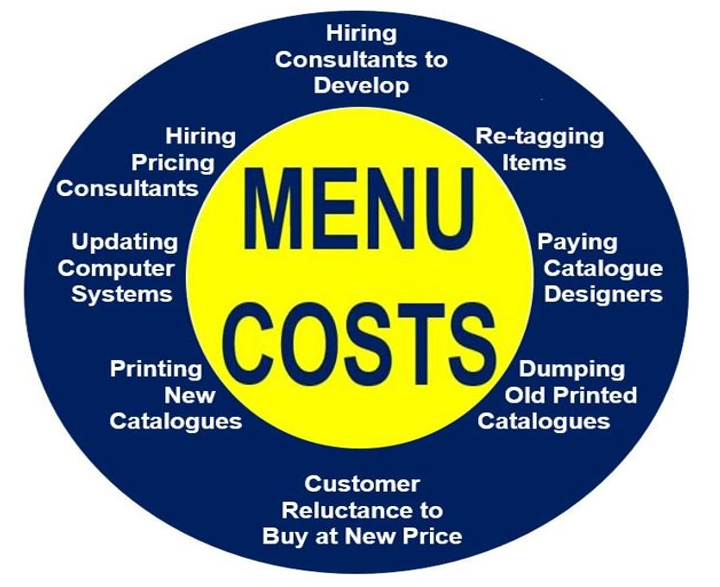The term Menu Costs in economics refers to the cost to a commercial enterprise resulting from a price change.
The term originates from the catering business – when a restaurant changes its prices, it has to design and print new menus – which costs money.
Economists use ‘menu costs’ when talking about the costs of changing nominal prices in general. Every time a firm raises or cuts the prices it charges, it faces a substantial outlay.
Menu costs are one of the ‘Costs of Inflation’.
If prices keep going up everywhere, you will eventually have to raise yours too, which means paying money for people to design new catalogs, printing them, and hiring experts to determine what the new prices should be.
In an economy with hyperinflation – 50% or more – menu costs are a serious problem because you have to keep changing your prices frequently.
In an article – ‘A Near-Rational Model of the Business Cycle, with Wage and Price Inertia‘ – published in The Quarterly Journal of Economics (1985), authors George Akerlof and Janet Yellen, who were at the University of California, Berkeley at the time, wrote that due to bounded rationality, firms would not want to change their price unless the benefit was more than a small amount.

Menu costs and ‘sticky prices’
Businesses are generally hesitant to alter their prices every time the supply-and-demand balance shifts because of the menu costs. When prices remain the same, despite a change in the supply-demand balance, we have sticky prices. When there are sticky prices, the market for a company’s output will be in disequilibrium (out of balance).
Lost sales is also something a company has to consider in its menu cost. A change in price might make customers reluctant to buy at a given price.
In most cases, a business will not change its prices until there is a large-enough disparity between the current price and the equilibrium market price.
Theoretically, a company should only consider changing its prices when the menu costs are less than the additional revenues the change is expected to bring.
Determining when the price change outweighs the menu costs is not easy – much of it is down to calculated guesswork.
Menu costs and e-commerce
As far as menu costs are concerned, the emergence of the Internet has been a godsend.
As online transactions continue representing a greater proportion of total transactions across national economies and globally, companies are becoming less concerned about menu costs, and are adjusting their prices to respond to the conditions of the marketplace much more quickly, compared to ten or twenty years ago.
For a company that does most of its business online, menu costs are considerably cheaper than they used to be. All it has to pay for today is the time an employee or contracted person has to spend changing the prices on its online catalogue and publicity material. Even new pricing strategies today can be done with the assistance of special computer programs.
Additionally, the widespread adoption of digital payment systems has further minimized menu costs, as dynamic pricing can be integrated directly into these platforms with minimal expense.
-
Watching each other’s prices
The Internet also means that businesses can watch each other’s prices, special offers, and promotional campaigns much more readily.
In fact, there is now dedicated software that tracks competitors’ prices and uses simple algorithms to respond within minutes, by either beating what rivals offer, or matching them automatically.
Whether these clever sales and marketing programs are good for companies’ profitability is questionable. While it may seem like a pro-competitive development, its real effect on prices and companies’ financial health could be perverse.
-
Striving to gain market share
The whole point of having price competition is to gain market share – lower your price and gain market share. The increase in sales outweighs the smaller margins.
However, if your competitors match your new prices virtually instantly, the incentive to lower prices is undermined – a reduction in price will not push up market share in such a business environment. The end result could be a downward spiral which would mean lower profits for everybody.
Arup Daripa and Sandeep Kapur, from the Birkbeck College, part of the University of London, made the following comment in an article they authored – ‘Pricing on the Internet‘:
“On the whole, the widespread prevalence of price-matching could result in higher prices in the aggregate.”
Do menu costs cause business cycles?
Economists have long been debating whether menu costs are large enough to cause business cycles.
David Levy et al published the results of a study – ‘The Magnitude of Menu Costs: Direct Evidence from Large U. S. Supermarket Chains‘ – in the Quarterly Journal of Economics (1991). They demonstrated that menu costs are indeed big enough to cause business cycles.
Levy and colleagues used store-level data from five supermarket chains to measure each one’s menu cost directly. They found that the menu cost per store averaged 35.2% of net profit margins, which could be forming a barrier to price changes.
The authors concluded that the menu costs they observed had macroeconomic significance.
They added that these menu costs might cause significant nominal rigidity in other markets or industries, thus increasing the effects on business cycles.
Video – What are Menu Costs?
This video presentation, from our sister channel on YouTube – Marketing Business Network, explains what ‘Menu Costs’ are using simple and easy-to-understand language and examples.
